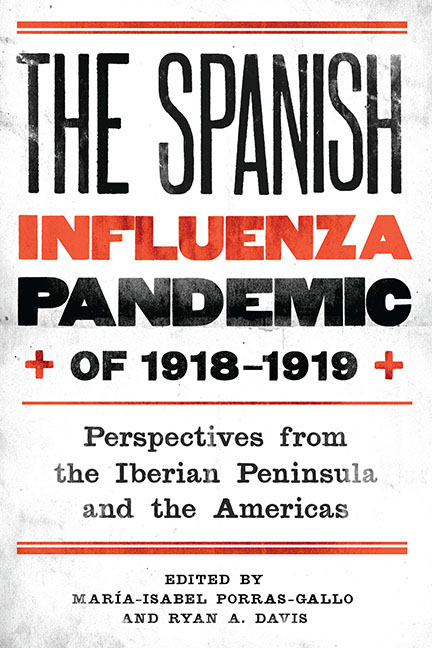 The Spanish Influenza Pandemic of 1918–1919
The Spanish Influenza Pandemic of 1918–1919 Book contents
- Frontmatter
- Dedication
- Contents
- Introduction: Emerging Perspectives of the Spanish Influenza Pandemic of 1918–19
- Part One Scientific Discourse: Now and Then
- Part Two Social Responses: Human and Institutional Actors
- 4 And to Make Things Worse, the Flu: The Spanish Influenza in a Revolutionary Portugal
- 5 Between the Pandemic and World War I: The 1918–19 Influenza Pandemic in the Spanish Army, through the Eyes of the Press
- 6 The Reign of the Spanish Flu: Impact and Responses to the 1918 Influenza Pandemic in Minas Gerais, Brazil
- 7 The Spanish Flu in Bahia, Brazil: Prophylaxis and Healing Practices
- 8 A Collaborative Experience: The Mutual Benefit Societies’ Responses to the 1918–19 Influenza Pandemic in Pamplona, Spain
- Part Three Interpreting the Epidemic: Sociocultural Dynamics and Perspectives
- Selected Bibliography
- List of Contributors
- Index
5 - Between the Pandemic and World War I: The 1918–19 Influenza Pandemic in the Spanish Army, through the Eyes of the Press
from Part Two - Social Responses: Human and Institutional Actors
Published online by Cambridge University Press: 14 March 2018
- Frontmatter
- Dedication
- Contents
- Introduction: Emerging Perspectives of the Spanish Influenza Pandemic of 1918–19
- Part One Scientific Discourse: Now and Then
- Part Two Social Responses: Human and Institutional Actors
- 4 And to Make Things Worse, the Flu: The Spanish Influenza in a Revolutionary Portugal
- 5 Between the Pandemic and World War I: The 1918–19 Influenza Pandemic in the Spanish Army, through the Eyes of the Press
- 6 The Reign of the Spanish Flu: Impact and Responses to the 1918 Influenza Pandemic in Minas Gerais, Brazil
- 7 The Spanish Flu in Bahia, Brazil: Prophylaxis and Healing Practices
- 8 A Collaborative Experience: The Mutual Benefit Societies’ Responses to the 1918–19 Influenza Pandemic in Pamplona, Spain
- Part Three Interpreting the Epidemic: Sociocultural Dynamics and Perspectives
- Selected Bibliography
- List of Contributors
- Index
Summary
As noted in the introduction to this volume, the 1918–19 influenza pandemic started when Spain was very backward in public health matters and when the political crisis and adverse socioeconomic conditions made it difficult to answer the call for modernization from different medical sectors and health authorities. The Military Medical Service, having undergone a radical transformation during the reign of Isabel II (1833–68), was fighting to achieve scientific supremacy vis-à-vis an impoverished Civilian Public Health Service. But the Spanish army needed to reorganize and improve some of its infrastructure for this to occur. For instance, the hygienic conditions of the barracks and the food the soldiers were receiving were rather poor. As we shall see, these conditions would become prominent during the pandemic and, for some people, responsible for its existence and gravity.
As Charles Rosenberg has noted, an epidemic offers a cross-section of society, helping to highlight the existing and latent problems a given community has at the time of the outbreak. Moreover, an epidemic as a social phenomenon takes the form of a theatrical drama. In a limited time and space, different social groups are forced to modify their usual dynamic and to perform various activities to address the critical situation. This results in the mobilization of their members to perform propitiatory rituals, incorporating and reaffirming their fundamental social and cultural values.
Taking Rosenberg's approach as a starting point and using as my main sources military scientific journals and newspapers, as well as the general and popular press, this chapter explores the reactions of Spain's Military Medical Service to the 1918–19 influenza pandemic. In what follows I focus on the social impact of debates as well as on tensions and conflicts between different sectors of society. For this reason I assess whether the Military Medical Service defended scientific opinions that were more modern than those of the Sanidad Civil (Civilian Health Service) and whether there were any conflicts of interest between the measures they both took in response to the epidemic, especially as related to soldiers.
- Type
- Chapter
- Information
- The Spanish Influenza Pandemic of 1918–1919Perspectives from the Iberian Peninsula and the Americas, pp. 93 - 110Publisher: Boydell & BrewerPrint publication year: 2014


